
BASILISKS
The following section on basilisk lizards has been included because of the similarity of care requirements between these species and water dragons. As display lizards, few can match a male double-crested basilisk. With their impressive crests, bright yellow eyes, and green to pastel green coloration and turquoise blue spots, these lizards are the closest thing to a living dragon you are likely to encounter. Large-scale breeding efforts are currently in progress for the commercial production of Basiliscus basiliscus and B. plumifrons, so the future availability of these spectacular lizards seems assured. Virtually all species of basilisks are offered in the pet trade, the rarest being the red-headed basilisk. Basilisks belong to the family Corytophanidae. Four species are recognized:

This is a hatchling double-crested basilisk.
• The common basilisk (B. basiliscus), found in areas from southern Central America to northwest Colombia.
• The red-headed basilisk (B. galleritus), found along the Pacific slopes of Colombia and Ecuador to Panama and Costa Rica.
• The green, or double-crested, basilisk (B. plumifrons), found in Panama, Costa Rica, and Nicaragua.
• The Central American basilisk (B. vittatus), found in Mexico through Central America, and into Colombia.
Size: The largest basilisks are male double-crested basilisks, which can reach a total length of nearly 3 feet. The smallest are the Central American or striped basilisks, which only grow up to 30 inches total length. Under optimal conditions, basilisks born and raised in captivity become sexually mature in eighteen to twenty-four months.
Sexing: Male basilisks have pronounced crests adorning the back of the head. Male B. basiliscus and B. plumifrons also have highly developed dorsal (back) and caudal (tail) crests.
Longevity: Basilisks live up to ten years, possibly more.
Selection: Use the selection guidelines listed for green water dragons.
Housing and Maintenance
Male basilisks cannot be kept together, as they are prone to vicious fighting. When fighting doesn’t occur, the health of subordinate animals will decline due to stress. Thus, keep only one male per enclosure. Depending on the size of the enclosure, more than one female can be kept with a male. Some breeders house groups of one male and up to three females. Otherwise, use the same maintenance guidelines presented for green water dragons.
You can use the same guidelines listed for green water dragons, except that adult basilisks, with the exception of very large male double-crested basilisks, don’t grow large enough to take weaned mice. Feed them early-stage fuzzy mice instead. Experts recommend a varied diet. King meal-worms can be used as the primary component of the diet with adults. Plant matter containing yellow pigments is particularly recommended for green basilisks. Captive-raised animals of this species are often bluish, presumably because of a lack of appropriate plant pigments in the diet. A lack of exposure to sunlight may also contribute to this.

Over parts of their range basilisks are called Lagardo de Jesus Christo (Jesus Christ Lizard) because of their ability to run on water for short distances.
Breeding
Use the guidelines listed for green water dragons, but basilisks do not breed at a low relative humidity (minimum 80 percent and preferably higher). Under ideal conditions, all species will double or triple clutch. Basilicus plumifrons lay up to four clutches of up to sixteen eggs per clutch. The size of the clutches partially depends on the age and size of the females. Basilicus basiliscus has been reported to lay up to eighteen eggs and B. vittatus up to fourteen eggs, although the average clutch size for the latter is between four and five eggs.
When rearing hatchlings, separate males as soon as sexual characteristics and/or fighting becomes apparent.
Incubation: Use the same incubation techniques listed for green water dragons.

Male double-crested basilisks are the largest basilisks, reaching a length of almost 3 feet.

Female double-crested basilisks do not have the pronounced crests found on male specimens.